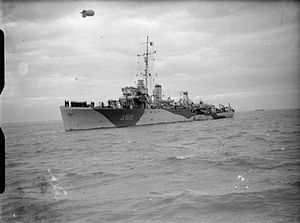 HMS Hussar (J82) during World War II HMS Hussar (J82) during World War II
| |
| History | |
|---|---|
| Name | HMS Hussar |
| Ordered | 23 February 1933 |
| Builder | John I. Thornycroft & Company, Woolston, Southampton |
| Laid down | 28 August 1933 |
| Launched | 27 August 1934 |
| Commissioned | 16 January 1935 |
| Fate | Sunk by RAF Hawker Typhoons on 27 August 1944 |
| Badge | On a Field Red, two light cavalry sabres Proper |
| General characteristics | |
| Class and type | Halcyon-class minesweeper |
| Displacement |
|
| Length | 245.25 ft (74.75 m) |
| Beam | 33.5 ft (10.2 m) |
| Draught | 6.75 ft (2.06 m) |
| Propulsion | 2 x Admiralty 3-drum water-tube boilers, Parsons steam turbines, 1,750 shp (1,305 kW) on 2 shafts |
| Speed | 16.5 knots (31 km/h) |
| Range | 7,200 nmi (13,330 km) at 10 knots (19 km/h) |
| Complement | 80 |
| Armament |
|
HMS Hussar was a Royal Navy Halcyon-class minesweeper of World War II.
As the Allied armies advanced following the invasion of Normandy, Hussar, Britomart, Jason and Salamander were assigned to the 1st Minesweeping Flotilla (1MF) clearing Axis minefields north of Normandy to open additional ports to supply the advance. On the afternoon of 27 August 1944, they were sweeping off Cap d'Antifer in preparation for the battleship Warspite and monitors Erebus and Roberts to engage Le Havre coastal artillery delaying the advance of Canadian troops.
The headquarters officer assigning the minesweeping project to 1MF neglected to inform the Flag Officer British Assault Area (Rear‑Admiral Rivett‑Carnac), who was responsible for defending the invasion beaches from E-boats operating out of Le Havre. 1MF was observed on a southwesterly leg of the minesweeping operation and assumed to be German ships proceeding to attack Allied shipping off the invasion beaches. The Admiral's staff requested No. 263 Squadron RAF and No. 266 Squadron RAF to attack the presumed enemy ships. The squadrons responded with 16 Typhoons armed with 20 mm cannon and High Explosive "60 lb" RP-3 unguided rockets. RAF pilots identified 1MF as apparently friendly shipping, but upon questioning their orders were told the Royal Navy had no ships in the area.
In a well-executed attack out of the sun at 13:30, the Typhoons sank Hussar and Britomart; and Salamander was damaged far beyond economical repair and written off as a constructive total loss. Eighty-six British sailors were killed and 124 more were injured. 1MF identified the Typhoons as friendly, and poor visibility into the sun prevented early recognition of the impending "friendly fire". Jason established radio contact to terminate the attack.
References
- ^ "SINKING OF HMS BRITOMART AND HMS HUSSAR BY FRIENDLY FIRE". Halcyon Class. Retrieved 27 January 2014.
| Halcyon-class minesweepers | |
|---|---|
| List of mine countermeasure vessels of the Royal Navy |
This article about a specific naval minesweeper of the United Kingdom is a stub. You can help Misplaced Pages by expanding it. |
- Halcyon-class minesweepers
- Ships sunk by British aircraft
- Friendly fire incidents of World War II
- 1934 ships
- Ships built in Southampton
- Maritime incidents in August 1944
- World War II shipwrecks in the English Channel
- Ships built by John I. Thornycroft & Company
- Minesweepers sunk by aircraft
- United Kingdom minesweeper stubs